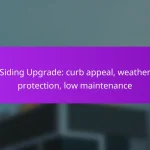Replacing windows is a significant home improvement project that requires careful consideration of various options, including double-glazed, triple-glazed, vinyl, wooden, and aluminium windows. The measurement process is critical to ensure a proper fit, while the installation techniques chosen can greatly affect the window’s performance and aesthetics. Understanding these elements will help you make informed decisions for a successful window replacement.

What are the best window replacement solutions in the UK?
The best window replacement solutions in the UK include double-glazed, triple-glazed, vinyl, wooden, and aluminium windows. Each option offers unique benefits and considerations, making it essential to evaluate them based on energy efficiency, aesthetics, and maintenance needs.
Double-glazed windows
Double-glazed windows consist of two panes of glass separated by a gap filled with air or gas, providing improved insulation. This type of window is widely popular in the UK due to its ability to reduce heat loss and noise pollution, making homes more comfortable and energy-efficient.
When considering double-glazed windows, check for the energy rating, which typically ranges from A to G, with A-rated windows being the most efficient. Installation costs can vary, but homeowners often see a return on investment through lower energy bills.
Triple-glazed windows
Triple-glazed windows feature three panes of glass, offering even better insulation than double-glazed options. They are ideal for homes in colder regions of the UK, as they significantly reduce heat loss and can enhance soundproofing.
While triple-glazed windows can be more expensive to install, they may lead to greater long-term savings on heating costs. Consider the additional weight and structural requirements when planning installation, as these windows may need stronger frames.
Vinyl windows
Vinyl windows are made from polyvinyl chloride (PVC) and are known for their durability and low maintenance. They are resistant to rot, fading, and peeling, making them a practical choice for many UK homeowners.
These windows come in various styles and colors, allowing for customization to match home aesthetics. Vinyl windows typically offer good insulation properties and are often more affordable than wood or aluminium options.
Wooden windows
Wooden windows provide a classic and elegant look, making them a popular choice for period properties in the UK. They offer excellent insulation but require regular maintenance to prevent rot and weather damage.
When selecting wooden windows, consider the type of wood and the finish used. Options like hardwoods can be more durable but may come at a higher cost. Ensure proper sealing and painting to extend their lifespan.
Aluminium windows
Aluminium windows are known for their strength and slim profiles, allowing for larger panes of glass and more natural light. They are resistant to corrosion and require minimal maintenance, making them suitable for modern homes.
While aluminium windows can be more expensive upfront, they offer longevity and energy efficiency, especially when thermally broken. Look for options with good insulation ratings to maximize energy savings.

How to measure for window replacement?
Measuring for window replacement involves determining the correct dimensions and ensuring the frame is suitable for new windows. Accurate measurements are crucial to avoid complications during installation and ensure a proper fit.
Measuring width and height
To measure the width and height of your window opening, use a tape measure. Start by measuring the width at three points: the top, middle, and bottom of the opening. Record the smallest measurement to ensure the new window fits properly.
For height, measure from the top of the opening to the bottom at three points: the left, center, and right. Again, use the smallest measurement to account for any irregularities in the frame. This method helps avoid gaps or misalignment during installation.
Checking for square frames
To ensure your window frame is square, measure the diagonals from corner to corner. If both diagonal measurements are equal, your frame is square. If they differ, adjustments may be necessary to achieve a proper fit.
Using a level can also help check for plumb and level conditions. If the frame is not square, it may lead to operational issues with the new window, such as difficulty opening or closing.
Accounting for trim and casing
When measuring for window replacement, consider any existing trim and casing. If you plan to keep the trim, measure the opening size without including it. If replacing the trim, measure the total width and height, including the trim, to ensure the new window accommodates these elements.
Additionally, be aware of the type of casing you want to use, as this can affect the overall dimensions. Standard casing can add a few centimeters to each side, so factor this into your measurements to avoid surprises during installation.

What are the installation techniques for window replacement?
Window replacement can be accomplished using several installation techniques, each suited for different situations and preferences. The choice of method impacts the window’s performance, aesthetics, and overall cost.
Full-frame installation
Full-frame installation involves removing the entire window unit, including the frame, and replacing it with a new one. This technique is ideal when the existing frame is damaged or when a different window size is desired. It allows for a complete inspection of the surrounding structure and can improve energy efficiency.
When opting for full-frame installation, ensure that the new frame is properly sealed and insulated to prevent air leaks. This method typically requires more labor and materials, leading to higher costs compared to other techniques.
Insert window installation
Insert window installation is a method where new windows are fitted into the existing frame without removing it. This technique is best for situations where the frame is in good condition and the same size window is being installed. It is generally quicker and less expensive than full-frame installation.
While insert installations can save time and money, they may not address underlying issues such as rot or poor insulation in the existing frame. Proper measurements are crucial to ensure a snug fit and optimal performance.
Retrofit installation
Retrofit installation involves adding new windows to the existing structure without major modifications. This method is often used in renovations where maintaining the original look is important. It can be a cost-effective solution when the existing frames are still sound.
However, retrofitting may not provide the same level of energy efficiency as full-frame installations. Homeowners should consider the potential for air leaks and ensure that the new windows are compatible with the existing structure to maximize performance.

What finishing details are important after window installation?
Finishing details after window installation are crucial for ensuring energy efficiency, aesthetic appeal, and long-term durability. Key aspects include sealing and caulking, interior trim installation, and exterior finishing options, each contributing to the overall performance and look of the window.
Sealing and caulking
Sealing and caulking are essential for preventing air and water leaks around the window frame. Use high-quality, weather-resistant caulk to fill gaps between the window and the wall, ensuring a tight seal that enhances energy efficiency.
When applying caulk, choose a product suitable for your climate; for instance, silicone caulk is ideal for areas with high moisture. Avoid using too much caulk, as it can create unsightly beads and may not adhere properly.
Interior trim installation
Interior trim installation enhances the visual appeal of the window and provides a finished look to the interior space. Common materials for trim include wood, MDF, or PVC, each offering different aesthetics and durability.
When installing trim, ensure it fits snugly against the wall and window frame. Use finishing nails or adhesive for secure attachment, and consider painting or staining the trim to match your interior decor.
Exterior finishing options
Exterior finishing options protect the window from weather elements and contribute to curb appeal. Options include painting, staining, or using vinyl wraps, each offering varying levels of maintenance and durability.
For painted finishes, choose high-quality exterior paint that withstands UV rays and moisture. If opting for vinyl, ensure it is UV-resistant to prevent fading. Regular maintenance checks can help prolong the life of these finishes and keep your windows looking new.

What are the common mistakes in window replacement?
Common mistakes in window replacement can lead to inefficiencies and increased costs. Key errors include incorrect measurements and poor sealing techniques, both of which can compromise the performance and longevity of the installation.
Incorrect measurements
Incorrect measurements are a frequent issue that can result in windows that do not fit properly. This can lead to gaps that allow air and water infiltration, reducing energy efficiency and causing potential damage over time.
To avoid measurement errors, always use a reliable tape measure and double-check your dimensions. Measure the width and height of the window opening at multiple points to ensure accuracy, as openings can often be uneven.
When replacing windows, consider the frame type and any necessary adjustments for insulation or trim. It’s advisable to allow for a small margin (typically around 1/4 inch) to accommodate any irregularities in the opening.
Poor sealing techniques
Poor sealing techniques can lead to significant air leaks and moisture issues, undermining the benefits of new windows. Proper sealing is essential to maintain energy efficiency and protect against water damage.
To ensure effective sealing, use high-quality caulk and weatherstripping materials that are appropriate for your climate. Apply caulk evenly around the window frame and check for any gaps that may need additional sealing.
Regularly inspect seals and weatherstripping after installation to catch any wear or damage early. This proactive maintenance can help extend the life of your windows and improve overall performance.

